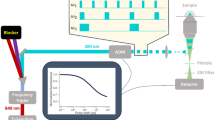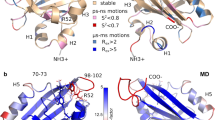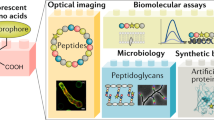Abstract
We designed and synthesized new, fluorescent, non-natural amino acids that emit fluorescence of wavelengths longer than 500 nm and are accepted by an Escherichia coli cell-free translation system. We synthesized p-aminophenylalanine derivatives linked with BODIPY fluorophores at the p-amino group and introduced them into streptavidin using the four-base codon CGGG in a cell-free translation system. Practically, the incorporation efficiency was high enough for BODIPYFL, BODIPY558 and BODIPY576. Next, we incorporated BODIPYFL-aminophenylalanine and BODIPY558-aminophenylalanine into different positions of calmodulin as a donor and acceptor pair for fluorescence resonance energy transfer (FRET) using two four-base codons. Fluorescence spectra and polarization measurements revealed that substantial FRET changes upon the binding of calmodulin-binding peptide occurred for the double-labeled calmodulins containing BODIPY558 at the N terminus and BODIPYFL at the Gly40, Phe99 and Leu112 positions. These results demonstrate the usefulness of FRET based on the position-specific double incorporation of fluorescent amino acids for analyzing conformational changes of proteins.
This is a preview of subscription content, access via your institution
Access options
Subscribe to this journal
Receive 12 print issues and online access
$259.00 per year
only $21.58 per issue
Buy this article
- Purchase on Springer Link
- Instant access to full article PDF
Prices may be subject to local taxes which are calculated during checkout




Similar content being viewed by others
References
Pelton, J.T. & McLean, L.R. Spectroscopic methods for analysis of protein secondary structure. Anal. Biochem. 277, 167–176 (2000).
Selvin, P.R. The renaissance of fluorescence resonance energy transfer. Nat. Struct. Biol. 7, 730–734 (2000).
Heyduk, T. Measuring protein conformational changes by FRET/LRET. Curr. Opin. Biotechnol. 13, 292–296 (2002).
Miyawaki, A. et al. Fluorescent indicators for Ca2+ based on green fluorescent proteins and calmodulin. Nature 388, 882–887 (1997).
Nagai, T., Yamada, S., Tominaga, T., Ichikawa, M. & Miyawaki, A. Expanded dynamic range of fluorescent indicators for Ca2+ by circularly permuted yellow fluorescent proteins. Proc. Natl. Acad. Sci. USA 101, 10554–10559 (2004).
Zhang, J., Campbell, R.E., Ting, A.Y. & Tsien, R.Y. Creating new fluorescent probes for cell biology. Nat. Rev. Mol. Cell Biol. 3, 906–918 (2002).
Hohsaka, T. & Sisido, M. Incorporation of non-natural amino acids into proteins. Curr. Opin. Chem. Biol. 6, 809–815 (2002).
Hohsaka, T., Ashizuka, Y., Murakami, H. & Sisido, M. Incorporation of nonnatural amino acids into streptavidin through in vitro frame-shift suppression. J. Am. Chem. Soc. 118, 9778–9779 (1996).
Hohsaka, T., Kajihara, D., Ashizuka, Y., Murakami, H. & Sisido, M. Efficient incorporation of nonnatural amino acids with large aromatic groups into streptavidin in in vitro protein synthesizing systems. J. Am. Chem. Soc. 121, 34–40 (1999).
Hohsaka, T., Ashizuka, Y., Sasaki, H., Murakami, H. & Sisido, M. Incorporation of two different nonnatural amino acids independently into a single protein through extension of the genetic code. J. Am. Chem. Soc. 121, 12194–12195 (1999).
Hohsaka, T., Ashizuka, Y., Taira, H., Murakami, H. & Sisido, M. Incorporation of nonnatural amino acids into proteins by using various four-base codons in an Escherichia coli in vitro translation system. Biochemistry 40, 11060–11064 (2001).
Murakami, H., Hohsaka, T., Ashizuka, Y., Hashimoto, K. & Sisido, M. Site-directed incorporation of fluorescent nonnatural amino acids into streptavidin for highly sensitive detection of biotin. Biomacromolecules 1, 118–125 (2000).
Taki, M., Hohsaka, T., Murakami, H., Taira, K. & Sisido, M. A non-natural amino acid for efficient incorporation into proteins as a sensitive fluorescent probe. FEBS Lett. 507, 35–38 (2001).
Hohsaka, T. et al. Position-specific incorporation of dansylated non-natural amino acids into streptavidin by using a four-base codon. FEBS Lett. 560, 173–177 (2004).
Hamada, H. et al. Position-specific incorporation of a highly photodurable and blue-laser excitable fluorescent amino acid into proteins for fluorescence sensing. Bioorg. Med. Chem. 13, 3379–3384 (2005).
Cornish, V.W. et al. Site-specific incorporation of biophysical probes into proteins. Proc. Natl. Acad. Sci. USA 91, 2910–2914 (1994).
Turcatti, G. et al. Probing the structure and function of the tachykinin neurokinin-2 receptor through biosynthetic incorporation of fluorescent amino acids at specific sites. J. Biol. Chem. 271, 19991–19998 (1996).
Steward, L.E. et al. In vitro site-specific incorporation of fluorescent probes into β-galactosidase. J. Am. Chem. Soc. 119, 6–11 (1997).
Cohen, B.E. et al. Probing protein electrostatics with a synthetic fluorescent amino acid. Science 296, 1700–1703 (2002).
Anderson, R.D., III, Zhou, J. & Hecht, S.M. Fluorescence resonance energy transfer between unnatural amino acids in a structurally modified dihydrofolate reductase. J. Am. Chem. Soc. 124, 9674–9675 (2002).
Kajihara, D., Hohsaka, T. & Sisido, M. Synthesis and sequence optimization of GFP mutants containing aromatic non-natural amino acids at the Tyr66 position. Protein Eng. Des. Sel. 18, 273–278 (2005).
Ikura, M. et al. Solution structure of a calmodulin-target peptide complex by multidimensional NMR. Science 256, 632–638 (1992).
Bayley, P.M., Findlay, W.A. & Martin, S.R. Target recognition by calmodulin: dissecting the kinetics and affinity of interaction using short peptide sequences. Protein Sci. 5, 1215–1228 (1996).
Lichtenthaler, F.W., Cuny, E., Morino, T. & Rychlik, I. Synthesis of 3′-homocitrullylamino- and 3′-lysylamino- 3′-deoxy-adenosine and their relation to Cordyceps militaris derived products. Chem. Ber. 112, 2588–2601 (1979).
dos Remedios, C.G. & Moens, P.D.J. Fluorescence resonance energy transfer spectroscopy is a reliable 'ruler' for measuring structural changes in proteins. Dispelling the problem of the unknown orientation factor. J. Struct. Biol. 115, 175–185 (1995).
Rasnik, I., McKinney, S.A. & Ha, T. Surfaces and orientations: much to FRET about? Acc. Chem. Res. 38, 542–548 (2005).
Majumdar, Z.K., Hickerson, R., Noller, H.F. & Clegg, R.M. Measurements of internal distance changes of the 30 S ribosome using FRET with multiple donor-acceptor pairs: quantitative spectroscopic methods. J. Mol. Biol. 351, 1123–1145 (2005).
Acknowledgements
We thank M. Valvano for the pSCRhaB2 plasmid; the Caenorhabditis Genetics Center for worm strains; and E. Entchev, L. Pelletier, J. Fu and members of the Genomics Department of TU Dresden for discussions. This work was supported by the European Union and Freistaat Sachsen, by Europäischer Fonds für regionale Entwicklung (EFRE) funding (project code 181) through the Sächsisches Staatsministerium für Wissenschaft und Kunst (SMWK) and Technische Universität Dresden (TUD), and by the Bundesminiterium fuer Bildung und Forschung (BMBF) Proteomics Program.
Author information
Authors and Affiliations
Corresponding author
Ethics declarations
Competing interests
The authors declare no competing financial interests.
Supplementary information
Supplementary Fig. 1
CBB-stained SDS-PAGE of labeled calmodulins. (PDF 203 kb)
Supplementary Fig. 2
Fluorescence spectra of double-labeled calmodulins. (PDF 422 kb)
Supplementary Fig. 3
Fluorescence spectra of single-labeled calmodulins. (PDF 417 kb)
Supplementary Fig. 4
Calcium dependence of double-labeled calmodulins. (PDF 426 kb)
Supplementary Fig. 5
Calcium dependence of double-labeled calmodulin-M13 fusion. (PDF 357 kb)
Supplementary Table 1
Fluorescent properties of BODIPYFL and BODIPY558. (PDF 82 kb)
Rights and permissions
About this article
Cite this article
Kajihara, D., Abe, R., Iijima, I. et al. FRET analysis of protein conformational change through position-specific incorporation of fluorescent amino acids. Nat Methods 3, 923–929 (2006). https://doi.org/10.1038/nmeth945
Received:
Accepted:
Published:
Issue Date:
DOI: https://doi.org/10.1038/nmeth945
This article is cited by
-
Characterization of protein unfolding by fast cross-linking mass spectrometry using di-ortho-phthalaldehyde cross-linkers
Nature Communications (2022)
-
Fluorescent amino acids as versatile building blocks for chemical biology
Nature Reviews Chemistry (2020)
-
Statistical description of the denatured structure of a single protein, staphylococcal nuclease, by FRET analysis
Biophysical Reviews (2018)
-
Highly chromophoric Cy5-methionine for N-terminal fluorescent tagging of proteins in eukaryotic translation systems
Scientific Reports (2017)
-
Non-canonical amino acids bearing thiophene and bithiophene: synthesis by an Ugi multicomponent reaction and studies on ion recognition ability
Amino Acids (2017)



